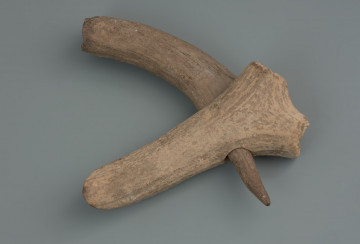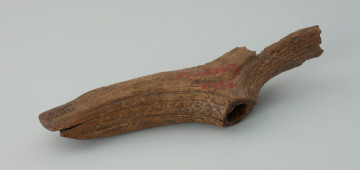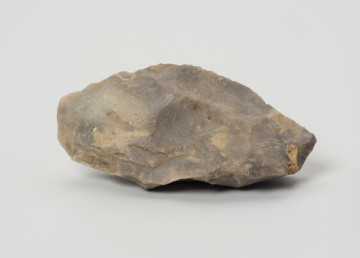
Axe with a handle
9600 p.n.e. — 5400 p.n.e.
National Museum in Szczecin
Part of the collection: Stone Age
The axe from red deer antlers was discovered in an unspecified place and circumstances, probably in the late 19th or early 20th century. Usually, the place of discovery is assumed to be Koszalin or its vicinity. Before 1909 it remained in the collection of the Scientific Society (Towarzystwo Naukowe) in Koszalin, then it was donated to the Gesellschaft für Pommersche Geschichte und Altertumskunde in Szczecin. The axe was made from a drop from the left beam of the antler of a medium-sized male. To shape the tool, the two lower antlers (brow tine and bay antler) were cut off, the beam was cut to the appropriate length, and then a hole was drilled for the handle with a bow drill with a wooden pin. In the final stage, the blade was shaped, oblique to the longitudinal axis, in a manner typical of Mesolithic antler tools, presumably due to their multifunctionality (e.g., woodworking, digging work). The axe is damaged. It has a scraped and dented surface and damages the spongiosa, i.e., a porous internal structure. Remains of gravel and sand preserved in the antler holes indicate that it was deposited in the sea or a rapid river. All this makes it impossible to interpret the traces of use. Antler axes are among the fairly common finds associated with early Holocene hunter-gatherer communities. Due to the natural conditions (humid climate, water bodies and peat bogs), many of them have been preserved in the northern part of Europe. They were often discovered during peatland exploitation in the 19th century. In the last 12,000 years, due to relatively rapid changes in the sea level in the Baltic Sea, vast areas of the coast have been flooded, so Stone Age tools are discovered on the seashore or are fished out by fishermen.
Michał Adamczyk
Author / creator
Dimensions
cały obiekt: height: 20.7 cm, width: 7 cm
Object type
axe, hatchet
Technique
cutting, drilling, planing, scraping
Material
red deer antlers
Origin / acquisition method
acquisition
Creation time / dating
Creation / finding place
Owner
National Museum in Szczecin
Identification number
Location / status

9600 p.n.e. — 5400 p.n.e.
National Museum in Szczecin

5400 p.n.e. — 4100 p.n.e.
National Museum in Szczecin

7800 p.n.e. — 7000 p.n.e.
National Museum in Szczecin
DISCOVER this TOPIC
Museum of King Jan III's Palace at Wilanów
DISCOVER this PATH
Educational path